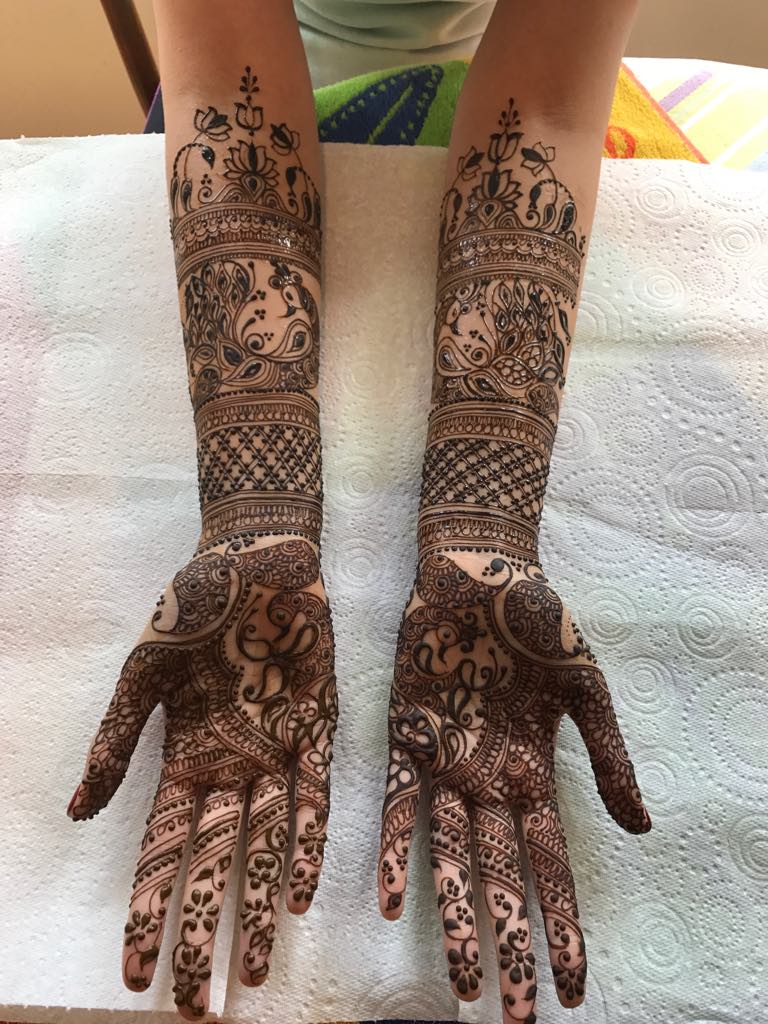I have always been passionate about arts and crafts; mainly focusing on creating floral patterns through the use of fabrics, ceramics and paints. I developed an interest in the art of henna, at a young age, when my work began to gain traction. I have been doing henna for weddings, parties and various other occasions ever since. Thereafter, I started doing my own Henna cones.
HENNA WORK/MEHNDI:
Henna powder is produce from the leaves of the Lawsonia Inermis plant. These leaves contain a red-orange dye named lawsone, which leaves a radiant stain on the skin. The powder is sifted and mixed with various ingredients, including essential oils such as: eucalyptus, lavender and tea tree etc.
My henna designs are very fine, unique and elegant with great detail. I initially draw custom and experimental bridal henna designs on paper that lead to eventual fruition on my brides.
My henna creations are based on traditional Indian patterns as well as Arabic floral and contemporary styles.
I do a free bridal consultation and a testing of the Henna designs, at the trial, before the wedding.
Bridal Henna for the bride can vary in size.
10 inches, up to the wrist, for both hands and both sides of the feet, up to the ankles.
14 inches, up to the mid-arm section, for both hands and both sides of the feet, up to the ankles.
16 inches, up to the elbow, for both hands and both sides of the feet, up to the ankles.
Henna for non-bridal party guests
Charges are per hour, per artist, for at least 2 to 3 hours per session. One artist does 10 to 12 line strips in an hour.
Professional Tips
DO’S
It is suggested that a client gets a manicure, pedicure and waxing done two days prior to Henna.
Wash your hands and feet with soap (NOT OILY SOAP) and make sure NOT to apply any cream or moisturiser.
Make sure Maiyan threads are tied above the area where you require Henna.
DONT’S
Do not use moisturiser before the appointment and make sure your hands are washed and dried with pure water.
Do not apply haldi (turmeric) paste on top of henna design.
Do not wash your hands immediately after scrapping the dried henna off your body. Avoiding water for 4-6 hours, after application, produces a stronger and long-lasting colour.
Avoid showering for at least 12 hours after the henna has been done. However if you do need to shower in this time, cover the Henna with gloves, cling film or plastic bags.
Do not shave an area of the body to which henna has been applied because it may take off the upper layers of the skin thus fading the appearance of the henna design.
HENNA AFTER CARE
After the henna is applied to the skin it dries in about 20 to 30 minutes.
Keep yourself warm during and after henna application to produce the deepest stain possible.
Henna should be on the skin for at least 6 to 10 hours. Preferably, leave the paste on for as long as possible until the henna dries and flakes off. The longer it is kept on the darker it will be.
Henna will stain clothing and the bed sheets, so pick off the remaining paste before going to bed if this concerns you.
When removing the paste, gently use a butter knife or just rub your hand on the dry henna to take it off. Alternatively use henna oil or coconut oil. Thereafter, the henna will be a light yellow or orange colour, eventually becoming darker.
Do not wash the area to which Henna has been applied for 24 hours, or if possible 48 hours will yield a better result.
To help preserve the Henna for longer apply lemon, sugar and water in equal ratio with a cotton ball.
Over the course of 48 hours, the henna stain will become progressively darker. During this time you can apply Vicks vapour or Tiger Balm to help act as a barrier to protect against water. This will assist your skin in generating heat to allow the stain to become darker. Do not apply any moisturiser with a fruit acid bleaching agent. HENNA WILL LAST BETWEEN 8 TO 10 DAYS.














